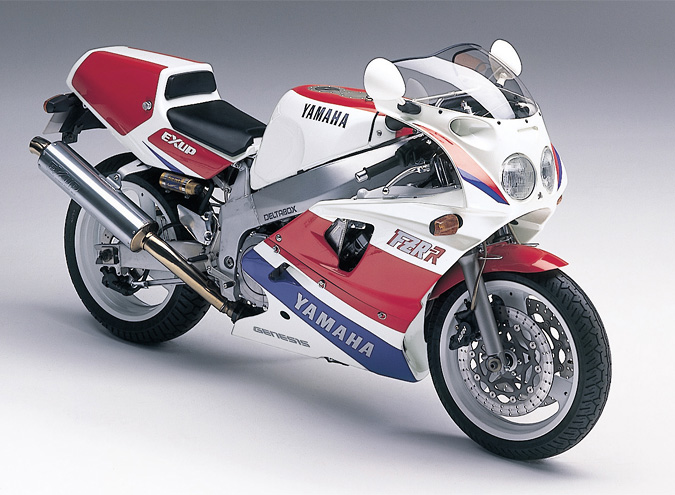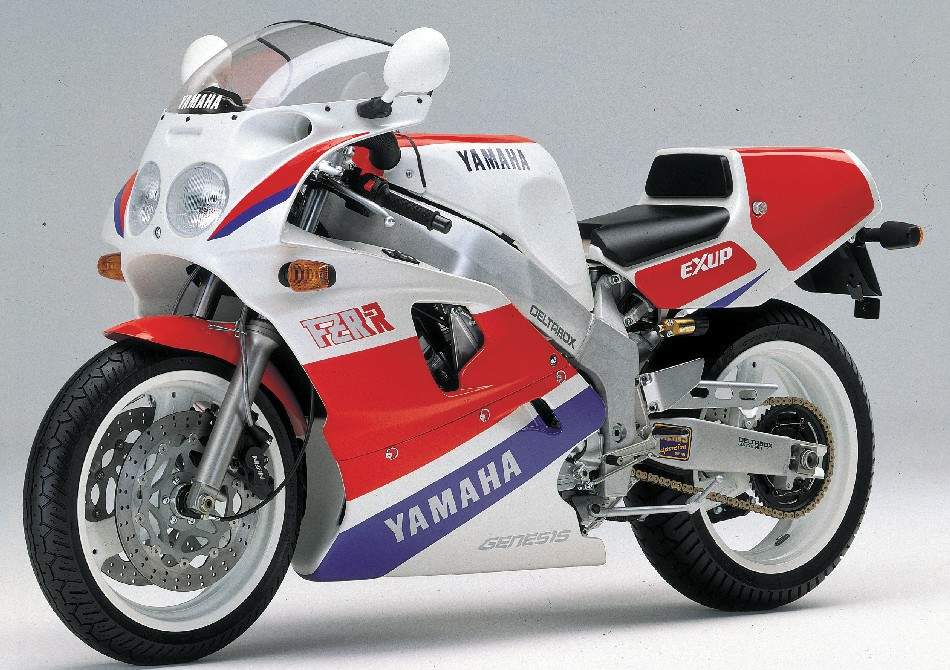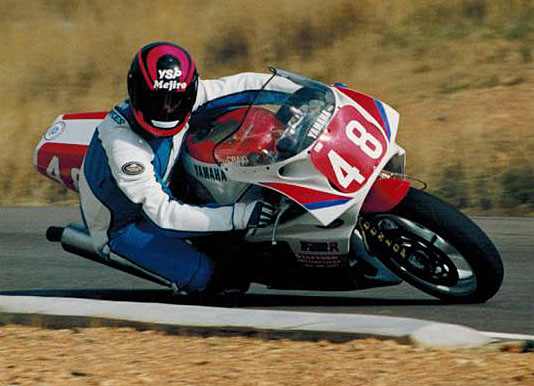Motorcycle Investor mag
Subscribe to our free email news

Yamaha FZR750R OW-01 1988-89 – future collectible
(updated Sept 2020)
by Guy 'Guido' Allen
Hidden Talents
Yamaha’s OW-01 had a whole lot more under the paint than its looks would suggest
Roll back to 1988 – before some of you were born – and there was a whole new world championship getting underway, namely World Superbike. The idea was the machines were closer in spec to actual street bikes than their exotic GP cousins, and a small volume manufacturer (such as Bimota) could homologate a special model for the series by building 200 examples. Bigger firms were required to make up to 1000.
To the considerable frustration of the big Japanese makers – Honda Yamaha, Suzuki and Kawasaki – it wasn’t really a level playing field. Their specialty was screaming high-performance four-cylinder toys and those machines were restricted to a 750 capacity, while V-twins (effectively Ducati at the time) could roll with 1000cc.
There was an argument that this enforced some form of performance parity, but it was a matter of hot debate at the time.
In any case, both Honda and Yamaha had a serious crack at overcoming the apparent disadvantage by building special models: the RC30 V-four from the 1988 season and the FZR750R OW-01 inline four from the 1989 title. Honda got the jump by a year and won the first two championships, with Fred Merkel in the saddle. That was before Ducati went onto dominate for the next three years.
As for Yamaha, its effort was spearheaded by the talented Fabrizio Pirovano, who won races but struggled to stitch together a winning championship. The closest he got was second in 1988 (on an FZR750-based machine) and again in 1990 on an FZR750R OW-01 – a formidable achievement.
From a distance, the OW-01 could easily have been mistaken by the uninitiated for a lightly-modified FZR1000 or even FZ750. And that, in the marketplace, probably didn’t help the machine’s profile when it was new.
Aside from its two championship wins, the rival Honda RC30 was producing some withering TT performances in the hands of the legendary Joey Dunlop and so it tended to completely overwhelm the Yamaha when it came to market presence.
The funny thing is, though, that the OW-01 was built in much lower numbers – 1000 versus 4782 – and was just as exotic when it came to spec.
For example, compared to an FZ750 (which was in its last year on the market) it ran 2mm bigger inlet valves and 1.5 larger exhaust. The bore and stroke dimensions changed to a hugely over-square 72 x 46mm, while the pistons were lighter two-ring items atop titanium conrods. Breathing was through a bank of 38mm flatslide carbs and hand-finished ports.
Remember this was during Yamaha’s five-valve period, so seeing inside one of these things would have been a treat. Overall it was intended to be lighter, more compact and stronger than its 750 road bike predecessors.
That lot was designed to redline at a dizzying 14,000rpm – very high for the period. Yamaha claimed a very healthy 120hp (88kW) at 12,000rpm matched to 70Nm of torque at 9000rpm.
Yamaha’s EXUP variable exhaust system, similar to what was used on the second-gen FZR1000, came across though in a somewhat different configuration – a four-butterfly set-up on two-on-two stacked headers.
Meanwhile the chassis probably owed more the YZF Formula 1 or endurance racer than it did the road bike range. Material qualities for the hand-welded Deltabox frame were up, while the whole was designed to be more compact and manouvreable. Plus, the engine was now a stressed member of the frame.
Up front you scored a premium 43mm Showa fork matched to an Ohlins rear monoshock. Naturally you scored full adjustment at both ends.
Special Nissin four-piston calipers worked 280mm discs on the sharp end, with a two-spot unit on the rear 177mm disc.
The bike came with a generous fuel tank – a whopping 23 litres - and all up it claimed a very credible 187kg dry weight.
Performance stats for the day claimed a 10.7sec time across the standing quarter, while top speed was just shy of 260km/h.
So what was it like to ride? Fast, light, and a very different bag of ferrets to either an FZR1000 or late-model FZ750. Where the road bikes paid more than a passing nod to comfort, the OW-01 was very much a race bike with lights.
Low clip-ons, high footpegs and a thinly-padded seat were warning enough of what you were in for. The suspension of course was firm by road standards, but had sufficient adjustment to suit a fairly broad variety of conditions.
As for the engine, it needed to be revved. Sure there was a reasonable mid-range in place, but really this was all about getting the powerplant singing the high notes up around the 10,000rpm mark or further.
Perhaps not surprisingly, a ride on both this and the RC30 revealed more than a few characteristics in common. For their day, and compared to a road bike, they felt like tiny little screaming Swiss watches.
With uncompromising ride positions and performance characteristics that really begged to be given a hard time on a track, they were very different from the normal showroom fare. The Yamaha felt the slightly bigger of the two machines and there’s no question the engine felt quite different from the Honda V-four with typical inline-four smoothness and a hackle-raising ability to pile on the revs till you’re convinced something has to break. But it never does.
Back in 1988-89, an OW-01 was something of a revelation to ride, Ultra-responsive in the turns, super-sharp on the brakes, and quicker than a scan of the spec sheet might have suggested. It was without doubt a very special ride.
Of course you paid for the privilege. At the time it was listed internationally at around a 40-50 per cent premium over the then current FZR1000, so you were looking at somewhere near the $18,000 mark. Add another 25-30 per cent for a factory race kit. At the time it seemed expensive, but it was a little less than the RC30 and, in retrospect, was probably a bargain.
The fact these don’t have anywhere near the profile of the rival Honda is also reflected in the current values. While a very good RC30 will set you back $60k-plus these days, an OW-01 is probably going to be closer to the $40k mark. So they’re still a bit of a bargain.
Pukka race homologation motorcycles values can do pretty well over the long term and I reckon this one has room for price growth. One good aspect is it should not be significantly more difficult to maintain than any normal road bike.
The trick will be to find a good one for sale, and being very careful to ensure it’s the real thing with the right engine in it. Happy hunting…

***

Problems?
You may hear of people talking about conrod failure, but this was not with the production bikes, but rather the race kits. Craig Stafford (pictured), who has very good first-hand knowledge, explains: "There were faulty conrod bolts supplied with the race kit. I know first-hand as one broke in turn One at Eastern Creek! (A very fast corner - Ed.) That was not pretty. Yamaha supplied new bolts, they broke again. Two engines gone. Then they got it right." (image supplied by author)
***
Mick’s FZR
Given the successes enjoyed by the legendary Aussie racer Mick Doohan with Honda, it’s sometimes easy to forget that his career was kicked off on Yamahas.
He enjoyed considerable success on machines related to the OW-01, including superbike wins in 1988 on the FZR750 (one in Japan, two in Australia) and some high profile rides on the YZF750 endurance racer.
Victories on the latter at Sugo and the Mt Fuji Super Sprint in 1988 saw at least a couple of factories chasing his signature on a race contract.
***
Good
Rare
Exotic spec
Fast
Bad
Hard to find
***
SPECS:
Yamaha FZR750R OW-01 1988-89
ENGINE:
TYPE: Liquid-cooled, five-valves per cylinder, inline four
CAPACITY: 747cc
BORE & STROKE: 72 x 45.7mm
COMPRESSION RATIO: 11.2:1
FUEL SYSTEM: 4 x 38mm flatslide Mikunis
TRANSMISSION:
TYPE: Six-speed, constant-mesh,
FINAL DRIVE: Chain
CHASSIS & RUNNING GEAR:
FRAME TYPE: Deltabox aluminium
FRONT SUSPENSION: 43mm Showa telescopic fork, full adjustment
REAR SUSPENSION: Ohlins monoshock, full adjustment
FRONT BRAKE: 280mm discs with four-piston Nissin calipers
REAR BRAKE: 177mm disc with two-piston caliper
DIMENSIONS & CAPACITIES:
WET WEIGHT: 215kg
SEAT HEIGHT: 785mm
WHEELBASE: 1485mm
FUEL CAPACITY: 23lt
TYRES:
FRONT: 120/70-ZR17
REAR: 170/60-ZR17
PERFORMANCE:
POWER: 88kW @ 12,000rpm
TORQUE: 70Nm @ 9000rpm
OTHER STUFF:
PRICE @ $18,000
-------------------------------------------------
Produced by AllMoto abn 61 400 694 722
Privacy: we do not collect cookies or any other data.

Archives
Contact



